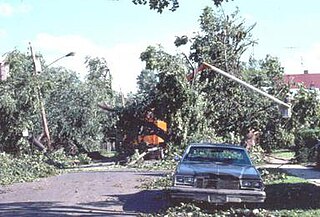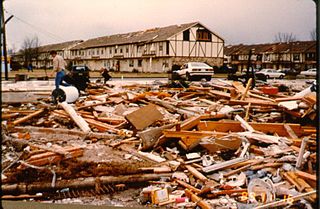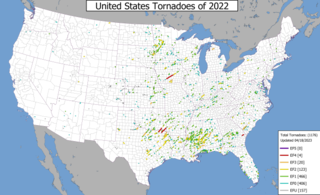
Hurricane Danny produced 13 significant (F2+) tornadoes in the Southern United States during August 1985, the most spawned by a tropical cyclone until Hurricane Ivan in 2004. The fourth named storm and third hurricane of the season, Danny developed from a tropical wave in the northwestern Caribbean Sea on August 12. The system moved northwestward and initially remained weak. Early on August 13, it brushed Cape San Antonio, Cuba before emerging the Gulf of Mexico later that day. The system then intensified into Tropical Storm Danny on August 14. Danny deepened further and became a hurricane early on the following day, while beginning to re-curve north-northwestward. Late on August 16, Danny attained its peak intensity with winds of 90 mph (150 km/h). Shortly thereafter, the storm made landfall near Grand Chenier, Louisiana at the same intensity. Early on August 17, Danny weakened to a tropical storm and was downgraded to a tropical depression several hours later. It moved east-northeastward across the Southeastern United States, until dissipating over southeastern Virginia on August 18.

From April 2–3, 1956, a large, deadly tornado outbreak affected the Great Plains, parts of the South, and the upper Midwest in the contiguous United States. The outbreak produced 47 tornadoes, including an F5 tornado that devastated the Hudsonville and Standale areas in the U.S. state of Michigan on April 3. It was one of three tornadoes to move across southwest Lower Michigan on that day. A fourth tornado struck north of the Manistee area. The Hudsonville-Standale tornado killed 17 and injured 292. These tornadoes were part of a tornado outbreak that took place on April 2–3, 1956, across the U.S. Midwest and the Great Lakes regions. In addition to the fatalities in Kansas, Oklahoma, Michigan and Berlin, Wisconsin, three people were killed in Tennessee, one person in Kentucky and two more people in Wisconsin. In total, 38 were killed during the entire event.

A destructive series of tornadoes in damage struck the Northeastern United States on July 10, 1989. The storm system affected five states with severe weather, including hail up to 2.5 inches (6.4 cm) across, thunderstorm winds up to 90 mph (140 km/h), and 17 tornadoes. Several towns in New York and Connecticut were particularly hard-hit. Several homes were leveled in Schoharie, New York and extensive damage occurred in Bantam, Connecticut. A large section of Hamden, Connecticut, including an industrial park and hundreds of homes, was destroyed; and in some places, buildings were flattened to the ground.

On April 2–5, 1957, a deadly tornado outbreak sequence struck most of the Southern United States. The outbreak killed at least 21 people across three states and produced at least 73 tornadoes from Texas to Virginia. The outbreak was most notable due to a tornado that hit a densely populated area of the Dallas–Fort Worth metropolitan area, killing 10 people and injuring 200 or more. The tornado, highly visible for most of its path, was at the time the most observed and best-documented tornado in recorded history; hundreds of people photographed or filmed the F3 tornado as it moved just west of Downtown Dallas. The film of this tornado is still known for its unusually high quality and sharpness, considering the photography techniques and technology of the 1950s. Damage from the Dallas tornado reached as high as $4 million. Besides the famous Dallas tornado, other deadly tornadoes struck portions of Mississippi, Texas, and Oklahoma. Two F4 tornadoes struck southern Oklahoma on April 2, killing five people. Three other significant, F2-rated tornadoes that day killed two people in Texas and one more in Oklahoma. An F3 tornado struck rural Mississippi on April 4, killing one more person.

The Wallingford Tornado was a violent tornado that struck the town of Wallingford, Connecticut, on Friday, August 9, 1878. The tornado, unofficially rated F4 by tornado expert Thomas P. Grazulis, destroyed most of the town, killing about 34 people—estimated totals varied—and injuring at least 70, many severely. This was the deadliest tornado ever to strike the state of Connecticut, and the second deadliest ever in New England, after the Worcester tornado of 1953.
On March 16–17, 1983, a significant severe weather event affected the island of Cuba and the southern Florida peninsula, including the Miami metropolitan area. A total of at least four tornadoes affected these regions; while as many as 17 were reported in South Florida, only two were confirmed in the official National Weather Service records. The strongest tornado produced F2 damage on the Fujita scale and skipped across the Everglades region from the eastern Big Cypress National Preserve through the Everglades and Francis S. Taylor Wildlife Management Area to Lighthouse Point—a path length of nearly 53 mi (85 km). An F1 tornado also affected Naples and Golden Gate. Additionally, unconfirmed tornadoes affected an RV park southeast of East Naples, as well as the Stuart and Jupiter areas, respectively. In addition to tornadoes, severe thunderstorms produced hail to 1 in (2.5 cm) in diameter, as well as rainfall totals of 1 to 2 in in some areas.

This page documents the tornadoes and tornado outbreaks of 1989, primarily in the United States. Most tornadoes form in the U.S., although some events may take place internationally. Tornado statistics for older years like this often appear significantly lower than modern years due to fewer reports or confirmed tornadoes.

This page documents the tornadoes and tornado outbreaks of 2014. Strong and destructive tornadoes form most frequently in the United States, Bangladesh, Brazil, and Eastern India, but they can occur almost anywhere under the right conditions. Tornadoes also appear regularly in neighboring southern Canada during the Northern Hemisphere's summer season, and somewhat regularly in Europe, Asia, and Australia.

This page documents notable tornadoes and tornado outbreaks worldwide in 2017. Strong and destructive tornadoes form most frequently in the United States, Brazil, Bangladesh, and Eastern India, but they can occur almost anywhere under the right conditions. Tornadoes also develop occasionally in southern Canada during the Northern Hemisphere's summer and somewhat regularly at other times of the year across Europe, Asia, Argentina and Australia. Tornadic events are often accompanied with other forms of severe weather, including strong thunderstorms, strong winds, and hail.

This page documents notable tornadoes and tornado outbreaks worldwide in 2020. Strong and destructive tornadoes form most frequently in the United States, Argentina, Brazil, Bangladesh, and eastern India, but can occur almost anywhere under the right conditions. Tornadoes also develop occasionally in southern Canada during the Northern Hemisphere's summer and somewhat regularly at other times of the year across Europe, Asia, Argentina, Australia and New Zealand. Tornadic events are often accompanied by other forms of severe weather, including strong thunderstorms, strong winds, and hail.

This page documents the tornadoes and tornado outbreaks of 1954, primarily in the United States. Most tornadoes form in the U.S., although some events may take place internationally. Tornado statistics for older years like this often appear significantly lower than modern years due to fewer reports or confirmed tornadoes.

A localized, but devastating series of severe thunderstorms affected the Great Lakes region during May 20-21, 1953. The strongest of these storms produced three intense, long-tacked tornadoes in Iowa, Michigan, and Ontario. The worst tornado event was a violent F4 tornado that tore through the cities of Port Huron, Michigan and Sarnia, Ontario on May 21, damaging or destroying hundreds of structures and causing dozens of casualties. Overall, the tornadoes killed eight people, injured 123 others, and caused at least $17.6 million (1953 USD) in damage. Thunderstorm winds also caused an additional fatality when a tree fell on a house in Waterloo, Iowa.

As Hurricane Isaias moved up the East Coast of the United States, a damaging outbreak of 39 tornadoes impacted areas from South Carolina to Connecticut between August 3–4, 2020. The most significant tornado of the outbreak was a large and intense EF3 tornado that obliterated a mobile home park near Windsor, North Carolina, killing two and injuring 14. This was the strongest tornado in the United States to be spawned by a tropical cyclone since 2005. In the end, the outbreak killed two and injured 26.
Five scattered tornadoes touched down across the Great Plains and Midwestern United States on June 19, 1951. The event was highlighted by a large, violent F4 tornado family that moved through the western and northern suburbs of Minneapolis, causing all the tornadic casualties from the outbreak. In all, one person was killed, 20 others were injured, and damage was estimated at $52.5 million. There was one additional death and six injuries from non-tornadic events as well.

This page documents notable tornadoes and tornado outbreaks worldwide in 2021. Strong and destructive tornadoes form most frequently in the United States, Argentina, Brazil, Bangladesh, and Eastern India, but can occur almost anywhere under the right conditions. Tornadoes also develop occasionally in southern Canada during the Northern Hemisphere's summer and somewhat regularly at other times of the year across Europe, Asia, Argentina, Australia and New Zealand. Tornadic events are often accompanied by other forms of severe weather, including strong thunderstorms, strong winds, and hail.

This page documents notable tornadoes and tornado outbreaks worldwide in 2022. Strong and destructive tornadoes form most frequently in the United States, Argentina, Brazil, Bangladesh, and Eastern India, but can occur almost anywhere under the right conditions. Tornadoes also develop occasionally in southern Canada during the Northern Hemisphere's summer and somewhat regularly at other times of the year across Europe, Asia, Argentina, Australia and New Zealand. Tornadic events are often accompanied by other forms of severe weather, including strong thunderstorms, strong winds, and hail.
This page documents the tornadoes and tornado outbreaks of 1948, primarily in the United States. Most tornadoes form in the U.S., although some events may take place internationally. Tornado statistics for older years like this often appear significantly lower than modern years due to fewer reports or confirmed tornadoes. Also, prior to 1950, tornadoes were not officially surveyed by the U.S. Weather Bureau, which would later become the National Weather Service, and thus had no official rating. All documented significant tornadoes were instead given unofficial ratings by tornado experts like Thomas P. Grazulis.

This page documents the tornadoes and tornado outbreaks of 1947, primarily in the United States. Most recorded tornadoes form in the U.S., although some events may take place internationally. Tornado statistics for older years like this often appear significantly lower than modern years due to fewer reports or confirmed tornadoes.















